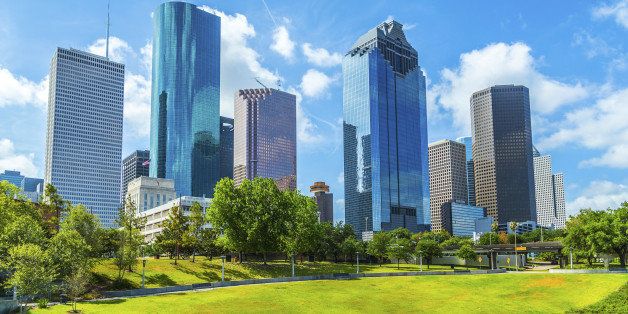
More than 195 nations have convened in Paris to discuss climate change, and what steps we must take to roll back its effects. This group of world leaders hopes to slow climate change by substantially decreasing the overall carbon emission rate; codify the temperature rise limit to 2 degrees Celsius in the coming decades; provide hundreds of billions in funding to poorer nations to adopt alternative energy; and foster a new green economy worldwide. But little discussed was the role of cities and urban inhabitants will need to play. Today, over 4 billion people across the world live in cities--and that figure will rise by 1.7% annually for the next 10 years, as the people young and old increasingly migrate to urban areas, drawn in for its diversity, innovation, opportunities, quality of life and convenience.
But there's a downside to city dwelling, one that could have a potentially devastating effect on our future: alienation from the natural world. How can we expect the next generation to value and preserve the outdoors if they are completely disconnected from it? It is critical that the outdoors become a part of the urban lexicon, parks and trails as much a part of daily life as streetlights and sidewalks. We must create opportunities for people to easily access the outdoors from cities and connect with nature within their urban habitat, fostering a generation of Outdoor Citizens united with the world around them and committed to the well being of our planet. To do so, we must commit to making every city an Outdoor City.
A World of Outdoor Cities
An Outdoor City provides its inhabitants with ways to both protect and connects with the natural world through robust outdoor-centric planning, programming, and engagement. Cities already lend themselves to greater conservation - including boasting an average carbon footprint that's 75% less than the suburbs. Decreased energy use; more walking and public transportation; and greater building density - meaning lower building energy use as well. Meanwhile, cities have been quick to embrace the sharing economy, seeing tremendous success with shared bikes, cars and urban food gardens.
Some cities are already leading the way, like San Francisco, which has introduced a number of alternative energy options over the years, like adding off-the-grid solar power stations for electric vehicles and green zoning incentives. Other cities are adopting energy-smart solutions that work within existing infrastructure. For instance, Current, powered by GE, is connecting street lights to the Industrial Internet by integrating software and sensors into LED fixtures. This solution, called Intelligent Cities, unlocks potential for data collection and monitoring, which can be used to help cities and their citizens make smarter energy decisions. From monitoring air quality, to improving traffic congestion--and thereby lowering idle emissions--intelligent solutions can help cities run cleaner and more efficiently.
"Cities are already upgrading lighting to LED for the significant energy savings, and adding intelligence to those lights offers huge potential to improve other areas of environmental impact," said Phil Mandry, General Manager - Sales, Intelligent Cities. "For instance, San Diego installed street light LEDs across the city in 2014, saving more than $250,000 in energy costs annually. The city is now piloting the Intelligent Cities solution to take that efficiency a step further."
But even in those places that have been slow to incorporate change in the way of urban planning, it is still possible to provide ways to connect with the natural world.
Educating Outdoor Citizens
Through the Youth Opportunities Program founded almost 50 years ago by the Appalachian Mountain Club, teachers and youth workers receive training in outdoor skills from map and compass reading to knot-tying to teaching others about the outdoors. Through experiential learning, participants develop a passion for the outdoors and conservation. For Miranda Rousamano, who grew up in New Haven, Connecticut, "being able to see beautiful places and have amazing experiences in them really contextualized protecting the environment for me. Now I am passionate about protecting those places and keeping them for other people to enjoy and recreate in," Miranda told me. Now pursuing a degree in outdoor education at Green Mountain College, "I can confidently say that if I didn't have access to that first trip I wouldn't be pursuing the career that I am."
Outdoor Access Through Technology
And with today's technology, urbanites no longer need to venture outside city limits to remain connected with the natural world. New technology makes it easier than ever to tap into best practices; the best in outdoor programming; engage and motivate outdoor citizens; measure impact and promote sustainability; and design, build and expand close-to-home recreational options. Like a new mobile app called Allgreenup that rewards you for your outdoor activity, recycling and energy savings. This Chilean start-up already has 12,000 users in their first 8 months. The Strava running and cycling app lets you keep track of your activity, see how you compare with friends on a leaderboard and integrates with other health app; Leafully is an app developed to help you keep track of your energy use and then converts that she into how many trees it takes to offset the carbon you produced. Who says technology and nature are mutually exclusive? One can continue to tap away on their digital devices while using them as a platform to conserve, learn, connect and share.
Embracing these and other opportunities moves us closer toward our goals of conservation stewardship and sustainability, enhances our quality of life, improves our health and for many of us, personally unlocks our own potential through outdoors-centric careers. Via Outdoor Cities, we must foster a new ethos of the outdoors and conservation in order to reduce our carbon consumption, pull back on the effects of climate change and collectively embrace fuller lives outdoors. Our world depends on it.